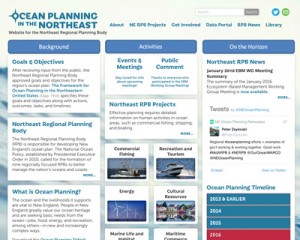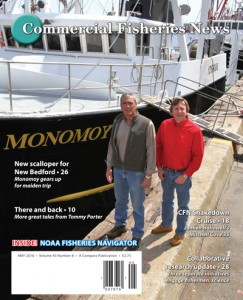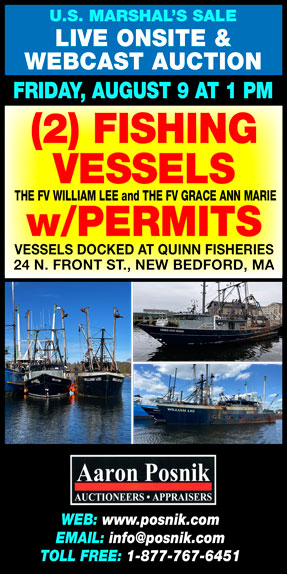In mid-May, an important New England ocean planning document will be released. Fishermen in the Northeast should take advantage of the 60-day public comment period that will follow.
 The Northeast Ocean Plan is a regionally developed blueprint that coordinates the activities of state and federal agencies responsible for New England ocean resources and involves local stakeholders whose livelihoods are affected by decisions on the water.
The Northeast Ocean Plan is a regionally developed blueprint that coordinates the activities of state and federal agencies responsible for New England ocean resources and involves local stakeholders whose livelihoods are affected by decisions on the water.
Drafted by the Northeast Regional Planning Body over the last four years – with extensive input from fishermen, scientists, the US Coast Guard, port managers, coastal business owners, energy developers, shipping companies, conservation groups, and others – the plan seeks to balance these multiple ocean uses, promoting a sustainable economy and resilient environment.
While New England is the first region of the US to draft such a plan, the Mid-Atlantic will soon follow and anticipates releasing its draft plan this summer. Fishermen who dock in New England, but fish in the Mid-Atlantic, will want to be aware of both plans.
In recent years, Commercial Fisheries News has published several articles that reference ‘ocean planning.’
(See https://fish-news.com/cfn/cfn-wind-energy-coverage).
But what is ocean planning, exactly?
And why do we need ocean planning now?
Historically, only hardened mariners, fishermen, and tradesmen made their living on the seas. However, in recent decades, new uses and industries have emerged. For example, places like the Gulf of Maine, Nantucket Sound, and the Mid-Atlantic Bight all have ideal conditions for offshore wind farms.
“Some may see the ocean as a vast open space, but really there is a lot that goes on out there: shipping, transportation, fishing, recreation, tourism, and national security operations” said Bruce Carlisle, director, Massachusetts Office of Coastal Zone Management.

The plan will be posted at here:
“The ocean is increasingly a busy place, with new proposals for wind and wave energy projects, LNG terminals, electric and telecommunication cables, and offshore sand excavation. Ocean planning represents a sea change in how we, as a nation, manage ocean resources.”
Likewise, environmental conditions such as rising seas, changing temperature patterns, acidification, and major weather events are wreaking havoc on everything from shellfish stocks to beaches – all issues fishermen are often the first to observe.
In challenging times like these, preserving high-value industries such as fisheries and tourism – and the ecosystem that supports them – is more important than ever to regional, economic security.
A few decades ago, leaders at both the regional and federal level anticipated the need to balance an increasingly crowded ocean with the multiple current and future ocean uses.
Under the Oceans Act of 2000, President George W. Bush appointed the US Commission on Ocean Policy, led by Admiral James D. Watkins (US Navy Ret.).
The resulting 2004 report, “An Ocean Blueprint for the 21st Century,” came to the conclusion that US coastal and ocean resources were in “serious trouble” and recommended a new approach for managing the ocean.
The new approach should:
- Base decisions on the most current, credible scientific information;
- Improve federal coordination and effectiveness; and
- Strengthen federal, state, tribal, and local efforts to identify and resolve issues.
Massachusetts, in 2009, and Rhode Island, in 2010, were the first to establish state ocean plans.
Subsequent bi-partisan, federal efforts in 2010 co-chaired by former Environmental Protection Agency (EPA) Administrator William Ruckelshaus, who served under the Nixon administration, and Norman Mineta, a Democrat who also served as Secretary of Transportation under the Bush administration, further developed many of the conclusions of the Watkins Commission.
They determined our greatest ocean problems were rooted in process:
- Ocean users had important data and insights, but often were not consulted in decision making; and
- State and federal agencies charged with regulating the ocean and coastal waters, development, ports, fish stocks, national maritime security, and other economic sectors operated along strict lines of jurisdiction, rather than working together on issues.
In response, the Obama administration directed federal agencies to correct these deficiencies through comprehensive ocean planning.
Congress is paying close attention to the Northeast and Mid-Atlantic ocean plans.
On April 10 in Washington, DC, leaders representing the Northeast Regional Planning Body offered their insights to congressional staff.
[pullquote align=”right” textalign=”center” width=”60%”]Want to contribute your thoughts to the Public Comment period for the Northeast Ocean Plan? A notice will be posted with details explaining how in a subsequent issue of Commercial Fisheries News. The plan will be posted at: <www.neoceanplanning.org/.> To view the data portal, see: <www.northeastoceandata.org/>.[/pullquote]
“This is a state’s rights issue,” said Ted Diers, administrator, New Hampshire Dept. of Environmental Services.
“Ocean planning allows states to participate fully in federal decision making. It’s the ticket to the dance to participate in decision making outside the three-mile limit. That’s why I’m involved.
“The ocean plan is built around a baseline of hard science and the soft science around how people work and recreate.”
Ocean plans have the potential to fundamentally improve how decisions are made.
“The ocean plan levels the playing field among all the agencies, tribes, and stakeholders to maintain sustainable uses of our ocean,” said Diers. “It gives us the tools to avoid conflicts before they start.”
In 2012, Hurricane Sandy
devastated the Eastern seaboard. It was the second most costly hurricane
in US history. But the cost didn’t stop with the storm.
When officials sought to restore New Jersey’s beaches by laying down tons of sand, they did so without evaluating how this action might later affect fisheries.
By contrast, a different scenario played out when Deepwater Wind proposed to build America’s first offshore wind farm, a five turbine 30 MW facility off the coast of Rhode Island.
Thanks to Rhode Island’s Special Area Management Plan – the state’s ocean plan – the siting process evaluated ocean users’ concerns, including lobster fishermen like Bill McElroy.
Concerned the proposed site would disturb lobster habitat, fishermen explained that if Deepwater Wind would move their turbines slightly it would greatly reduce impacts to lobster – and to lobster fishermen.
Deepwater Wind CEO Jeff Grybowski often praises ocean planning because negotiating in person, rather than defaulting to litigation, saved Deepwater Wind years in the permitting process.
As for the fishermen, advanced planning empowers people whose livelihoods are on the line.
Said McElroy of the experience: “It made us realize that we might not get everything we want, but we are getting most of it, and we are getting a seat at the table and have the opportunity to give them our opinion.”
This is why it is important for fishermen to familiarize themselves with the draft ocean plans proposed for the Northeast and Mid-Atlantic and provide feedback during the public comment period.
Consisting of five chapters, the Northeast Plan describes information for ocean resources and activities, including marine life and habitat; cultural resources; marine transportation; national security; commercial and recreational fishing; recreation; energy and infrastructure; aquaculture; and offshore sand resources.
Data for these topics was collected from multiple, existing sources, said John Weber, executive director, Northeast Regional Ocean Council, and as part of the plan’s development, data gaps were identified from public input, with extensive expert and scientific review.
Where there were data gaps, either new data was created, or the need for information was flagged for the future.
“Chapter three of the plan explains how these data will inform federal agency actions,” said Weber. “For example, the fishing industry can see how agencies will be applying the maps of fishing activity that industry members, scientists, and managers helped develop.”
New England Fishery Management Council members Doug Grout of New Hampshire, followed by Mark Alexander of Connecticut, have served on the Northeast Regional Planning Body representing the interests of fishermen and fishery management in the planning process.
But these ocean plans are not static reports; rather, they are iterative documents that depend on the observations and insights of fishermen working on the water.
Furthermore, ocean plans serve fishermen in another important way.
Because fishermen lead busy lives, often at sea when decisions are being made, regional ocean plans make it easier for fishermen to track the regulatory actions of federal and state agencies that might impact their fisheries.
Fishermen should have some confidence that their data is integral to decision making.
“Ocean plans will compel federal agencies to do a better job of engaging fisheries,” said John Williamson, former fishery management council member and consultant on fisheries in planning.
“This means that in the future, before a major development such as a wind farm is permitted, affected fishing communities will be identified at the earliest stages, fishermen will be consulted, and their interests will be considered upfront when there is the most opportunity to shape results.
“Anyone with a computer will have access to all the information being used for decision making, such as locations of fishing grounds and their value.
“It’s important for fishermen to read these plans and support changes in the ways that federal agencies do business.”
Amy Trice is an aquatic ecologist who works as a policy analyst for Ocean Conservancy tracking ocean planning processes throughout the United States. A native Georgian, Amy grew up fishing with her father and grandfather.

To get all of the stories and much more you’ll need the MAY 2016 issue of Commercial Fisheries News – please choose from the following options:
BUY a Single PRINT edition of CFN that is delivered by MAIL. PRINT EDITION
Quickly enjoy ONLINE access with our Hi-DEF flip-book. PURCHASE ONLINE EDITION
(Read online flip-book immediately with purchased access key and download a copy for yourself to keep. Not sure if it works for you? Try a FREE SAMPLE HERE.)
SAVE BIG when you SUBSCRIBE!







